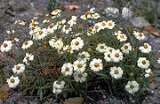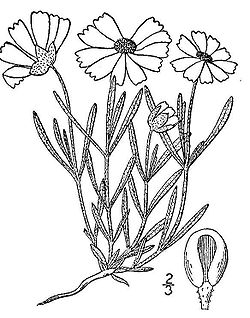
Melampodium
Encyclopedia
Melampodium a genus of flowering plant
s in the sunflower
family, Asteraceae
.
The 39 species it contains are commonly known as blackfoots. They are rugged plants native to the tropical to subtropical regions that include Central America
, Southwestern United States
, California
, Florida
, the Caribbean
, and South America
. Most of the species can be found in Mexico
, five in the Southwestern United States, and three are scattered in Colombia
and Brazil
.
The genus consists of annuals
and perennials
or bushy plants, growing to a height of 1 m. When fully grown, they tend to fall over. They like average, well-drained soil, but can equally grow on rocky soil in deserts. They are moderately to highly drought- and heat-tolerant. Three species of the so-called white-rayed complex are xerophytic.
The foliage varies from bright green to grey-green. The opposite leaves
are narrow and about 2-5 cm long.
The terminal flower
heads are about 2.5 cm wide. They give a continuous display of white (only in the three species of the white-rayed complex), cream, or yellow daisylike ray florets, surrounding a darker orange center with the disc florets. These eight to 10 broad disc florets are functionally staminate. The five outer bract
s are partially joined for about half their length.
The numerous fruit
s are seed-like (they consist of inner involucral bracts each enclosing and fused with individual ray achenes), with a few narrow scales at their tip. They make this genus one of the most prolific of the summer annuals, with seedlings coming up constantly.
The genus displays a large number of haploid chromosome
numbers are based on 4 basic chromosome numbers ( x = 9, 10, 11, 12).
Several cultivar
s of Melampodium leucanthum have been developed, such as 'Million Gold' and 'Showstar', mostly to achieve a more compact size.

Flowering plant
The flowering plants , also known as Angiospermae or Magnoliophyta, are the most diverse group of land plants. Angiosperms are seed-producing plants like the gymnosperms and can be distinguished from the gymnosperms by a series of synapomorphies...
s in the sunflower
Sunflower
Sunflower is an annual plant native to the Americas. It possesses a large inflorescence . The sunflower got its name from its huge, fiery blooms, whose shape and image is often used to depict the sun. The sunflower has a rough, hairy stem, broad, coarsely toothed, rough leaves and circular heads...
family, Asteraceae
Asteraceae
The Asteraceae or Compositae , is an exceedingly large and widespread family of vascular plants. The group has more than 22,750 currently accepted species, spread across 1620 genera and 12 subfamilies...
.
The 39 species it contains are commonly known as blackfoots. They are rugged plants native to the tropical to subtropical regions that include Central America
Central America
Central America is the central geographic region of the Americas. It is the southernmost, isthmian portion of the North American continent, which connects with South America on the southeast. When considered part of the unified continental model, it is considered a subcontinent...
, Southwestern United States
Southwestern United States
The Southwestern United States is a region defined in different ways by different sources. Broad definitions include nearly a quarter of the United States, including Arizona, California, Colorado, Nevada, New Mexico, Oklahoma, Texas and Utah...
, California
California
California is a state located on the West Coast of the United States. It is by far the most populous U.S. state, and the third-largest by land area...
, Florida
Florida
Florida is a state in the southeastern United States, located on the nation's Atlantic and Gulf coasts. It is bordered to the west by the Gulf of Mexico, to the north by Alabama and Georgia and to the east by the Atlantic Ocean. With a population of 18,801,310 as measured by the 2010 census, it...
, the Caribbean
Caribbean
The Caribbean is a crescent-shaped group of islands more than 2,000 miles long separating the Gulf of Mexico and the Caribbean Sea, to the west and south, from the Atlantic Ocean, to the east and north...
, and South America
South America
South America is a continent situated in the Western Hemisphere, mostly in the Southern Hemisphere, with a relatively small portion in the Northern Hemisphere. The continent is also considered a subcontinent of the Americas. It is bordered on the west by the Pacific Ocean and on the north and east...
. Most of the species can be found in Mexico
Mexico
The United Mexican States , commonly known as Mexico , is a federal constitutional republic in North America. It is bordered on the north by the United States; on the south and west by the Pacific Ocean; on the southeast by Guatemala, Belize, and the Caribbean Sea; and on the east by the Gulf of...
, five in the Southwestern United States, and three are scattered in Colombia
Colombia
Colombia, officially the Republic of Colombia , is a unitary constitutional republic comprising thirty-two departments. The country is located in northwestern South America, bordered to the east by Venezuela and Brazil; to the south by Ecuador and Peru; to the north by the Caribbean Sea; to the...
and Brazil
Brazil
Brazil , officially the Federative Republic of Brazil , is the largest country in South America. It is the world's fifth largest country, both by geographical area and by population with over 192 million people...
.
The genus consists of annuals
Annual plant
An annual plant is a plant that usually germinates, flowers, and dies in a year or season. True annuals will only live longer than a year if they are prevented from setting seed...
and perennials
Perennial plant
A perennial plant or simply perennial is a plant that lives for more than two years. The term is often used to differentiate a plant from shorter lived annuals and biennials. The term is sometimes misused by commercial gardeners or horticulturalists to describe only herbaceous perennials...
or bushy plants, growing to a height of 1 m. When fully grown, they tend to fall over. They like average, well-drained soil, but can equally grow on rocky soil in deserts. They are moderately to highly drought- and heat-tolerant. Three species of the so-called white-rayed complex are xerophytic.
The foliage varies from bright green to grey-green. The opposite leaves
Leaf
A leaf is an organ of a vascular plant, as defined in botanical terms, and in particular in plant morphology. Foliage is a mass noun that refers to leaves as a feature of plants....
are narrow and about 2-5 cm long.
The terminal flower
Flower
A flower, sometimes known as a bloom or blossom, is the reproductive structure found in flowering plants . The biological function of a flower is to effect reproduction, usually by providing a mechanism for the union of sperm with eggs...
heads are about 2.5 cm wide. They give a continuous display of white (only in the three species of the white-rayed complex), cream, or yellow daisylike ray florets, surrounding a darker orange center with the disc florets. These eight to 10 broad disc florets are functionally staminate. The five outer bract
Bract
In botany, a bract is a modified or specialized leaf, especially one associated with a reproductive structure such as a flower, inflorescence axis, or cone scale. Bracts are often different from foliage leaves. They may be smaller, larger, or of a different color, shape, or texture...
s are partially joined for about half their length.
The numerous fruit
Fruit
In broad terms, a fruit is a structure of a plant that contains its seeds.The term has different meanings dependent on context. In non-technical usage, such as food preparation, fruit normally means the fleshy seed-associated structures of certain plants that are sweet and edible in the raw state,...
s are seed-like (they consist of inner involucral bracts each enclosing and fused with individual ray achenes), with a few narrow scales at their tip. They make this genus one of the most prolific of the summer annuals, with seedlings coming up constantly.
The genus displays a large number of haploid chromosome
Chromosome
A chromosome is an organized structure of DNA and protein found in cells. It is a single piece of coiled DNA containing many genes, regulatory elements and other nucleotide sequences. Chromosomes also contain DNA-bound proteins, which serve to package the DNA and control its functions.Chromosomes...
numbers are based on 4 basic chromosome numbers ( x = 9, 10, 11, 12).
Several cultivar
Cultivar
A cultivar'Cultivar has two meanings as explained under Formal definition. When used in reference to a taxon, the word does not apply to an individual plant but to all those plants sharing the unique characteristics that define the cultivar. is a plant or group of plants selected for desirable...
s of Melampodium leucanthum have been developed, such as 'Million Gold' and 'Showstar', mostly to achieve a more compact size.
Species

- Melampodium americanum
- Melampodium appendiculatum B.L.Rob.
- Melampodium argophyllum
- Melampodium aureum
- Melampodium bibractatum
- Melampodium cinereum DC. – Hoary Blackfoot
- Melampodium cinereum var. cinereum
- Melampodium cinereum var. hirtellum
- Melampodium cinereum var. ramosissimum
- Melampodium costaricense
- Melampodium cupulatum
- Melampodium diffusum
- Melampodium divaricatum (Rich.) DC. – Butter Daisy
- Melampodium glabrum
- Melampodium glabribracteatum
- Melampodium gracile
- Melampodium leucanthum Torr. & A.Gray (=Melampodium paludosum Kunth) – Plains Blackfoot
- Melampodium linearifolium
- Melampodium longicorne A.Gray – Arizona Blackfoot
- Melampodium longifolium
- Melampodium longipes
- Melampodium longipilum
- Melampodium mayfieldii
- Melampodium microcephalum
- Melampodium mimulifolium
- Melampodium moctezumum
- Melampodium montanum
- Melampodium nayaritense
- Melampodium northingtonii
- Melampodium nutans
- Melampodium paniculatum
- Melampodium perfoliatum (Cav.) Kunth – Perfoliate Blackfoot
- Melampodium pilosum
- Melampodium pringlei
- Melampodium repens
- Melampodium rosei
- Melampodium sericeum Lag. – Rough Blackfoot
- Melampodium sinaloense
- Melampodium sinuatum
- Melampodium strigosum Stuessy – Shaggy Blackfoot
- Melampodium tenellum
- Melampodium tepicense
Formerly placed here
- Acanthospermum australeAcanthospermum australeAcanthospermum australe is an herbaceous plant...
(Loefl.) Kuntze (as M. australe Loefl.) - Acanthospermum humile (Sw.) DC. (as M. humile Sw.)
- Eleutheranthera ruderalis (Sw.) Sch.Bip. (as M. ruderale Sw.)

